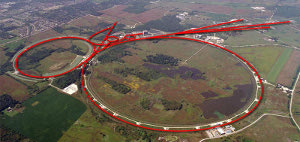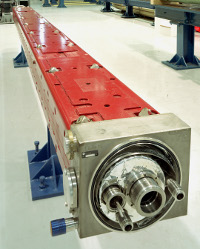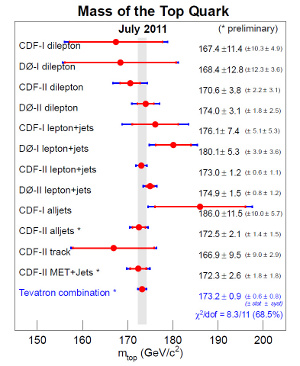The Division of Particles and Fields (DPF) of the American Physical Society held a major conference for the field at Brown University in Providence, Rhode Island from 9-13 August. A very interesting feature of the meeting was a celebration of the Tevatron, in anticipation of its being turned off later this month. The CERN Large Hadron Collider is replacing it as the primary facility to study high energy hadron collisions. At DPF, the physics accomplishments of the Tevatron were reviewed and celebrated by Paul Grannis of Stony Brook University, and the history and impressive evolution of the Tevatron collider complex by Steve Holmes of Fermilab.
In the 1960s, the “National Accelerator Laboratory” was conceived and funded by the US government as a new laboratory that would house the most ambitious accelerator in the world, a 400-GeV proton synchrotron. Under the leadership of Robert Wilson, the machine was built as a fixed-target facility that quickly became a major laboratory studying a broad range of high-energy physics experiments. In fact, I personally became involved in developing neutrino beams and studying high-energy neutrino collisions.
Despite the success of the original accelerator and important physics results, the quest for yet higher energies remained very strong. At Fermilab, a programme was undertaken to double the energy of the machine by making it a superconducting accelerator. A large and successful effort resulted in developing the magnets that would make this possible. But doubling the energy would not get to the energy scale needed and, as a result, the programme evolved towards making a proton-antiproton collider. By colliding beams of protons and antiprotons, much higher energies in the centre-of-mass system can be achieved.
Fermilab adopted the approach of colliding protons with antiprotons, which required many new concepts and technologies, including making and storing large numbers of antiprotons. Over the period of the Tevatron collider, through innovative developments, the performance was increased by a factor of 400 compared to the initial collider performance.
The physics from the Tevatron was accomplished by two large colliding-beam detectors, which have been precursors for the present generation of colliding-beam detectors at the LHC. Fermilab’s CDF and D0 detectors began with quite different emphases, but as the physics became better known, and therefore the detector requirements, they evolved to become more alike. The physics programme as reviewed by Paul Grannis was characterised as covering six areas: (1) quantum chromodynamics (QCD); (2) heavy flavours; (3) searches beyond the Standard Model; (4) electroweak physics; (5) top quark; and (6) search for the Higgs.
The top quark was a key discovery that was made at the Tevatron simultaneously by the CDF and D0 detectors in 1995, after several years of searching until enough integrated luminosity was recorded to carry out the analysis at the level required to make the discovery. This was a very impressive achievement and following the discovery, a wide variety of measurements, including those of the production cross-section, mass, decay modes and other properties, have been produced and now continue at the LHC.
The Tevatron and the CDF and D0 detectors have been the centre of our field for several decades, yet they must now give way to the excitement (and soon discoveries) of the new LHC collider and its ATLAS, CMS and LHCb detectors. Nevertheless, Fermilab is planning to remain at the forefront of particle physics over the coming years by developing new high-intensity lower-energy accelerators. I join in celebrating the Tevatron and in wishing Fermilab success as it moves in new directions.





Recent Comments